Feelings
post by Eris Discordia (oren-montano) · 2022-10-13T17:48:16.751Z · LW · GW · 0 commentsContents
A Brief History I Feel Therefor I Am The Emotional Machine Y Axis : Directional Preference X Axis : Is My Preference Happening? Z Axis : Is This Predictive Success? The Fourth Emotional Dimension : Predictable or Chaotic 4 Dimensional Emotions Additional Examples Functional Emotions The Emotion Card Why is this important? Psychology of Self Cognition Artificial General Intelligence None No comments
A Brief History
"Reason alone can never be a motive to any action of the will… it can never oppose passion in the direction of the will… The reason is, and ought to be, the slave of the passions, and can never pretend to any other office than to serve and obey them"
These words were written by David Hume's A Treatise of Human Nature in 1773.[1]
We have had philosophical systems that put the wills or the motive forces in their rightful place in the hierarchy of action choices for a long time. The idea being that there's a process outside rationality making selections based on the reality the personality inhabits that are evolutionarily benefiting the human animal.
I intend to argue that emotions are not a separate phenomenon from rational thought, but are instead a core functional component for assembling the rational universe.
I Feel Therefor I Am
Everything we humans care about.
Everything we notice.
Everything in the rational human universe exists because at some point in time a human had a feeling about it enough to care about it and turn it into part of their shared existence with other human beings.
The Emotional Machine
I had set myself the goal of building an artificial general intelligence based in part on Marvin Minsky's emotion machine. I tried working out what it would take to model what I knew about emotions as a biologist and trying out functional abstractions for them as a computer scientist.
I had both personal and educational exposure to psychological concepts so I began with the discrete emotions and tried imagining what each might look like as a function. Here is an entire article on the various models people have tried before.
While looking into the possibility, I ran across the continuous emotional model (figure 1 [2]) and after staring at that for a while, realized I was looking at a four dimensional space. (figure 2)
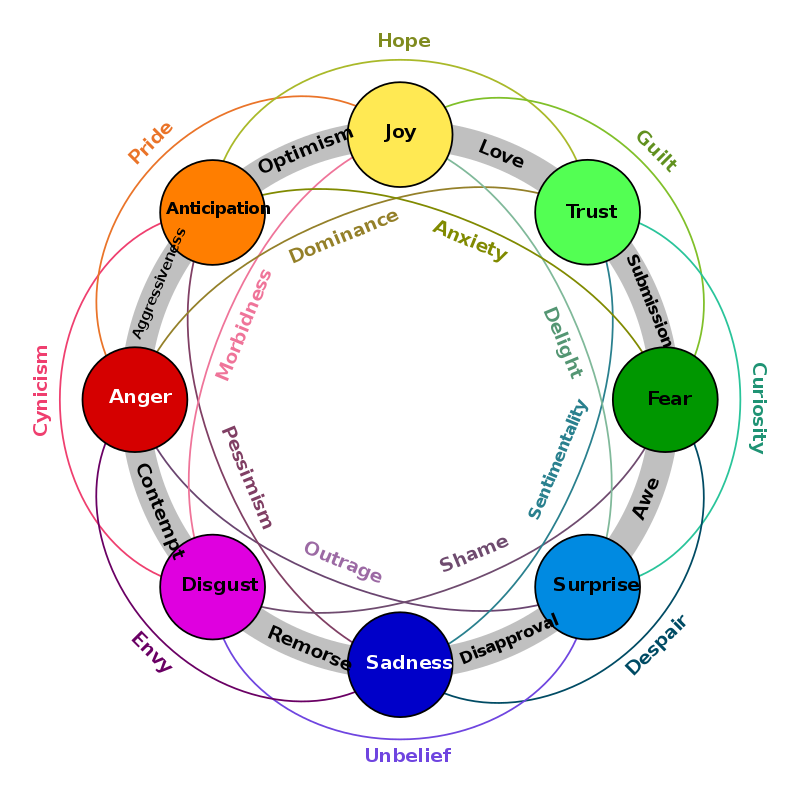
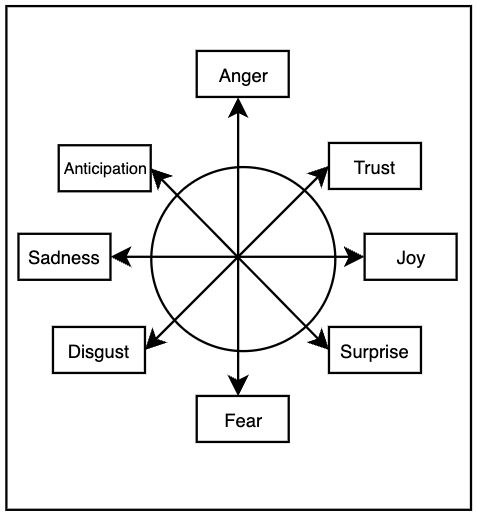
Staring at it a while longer and thinking through what some of the neurotransmitters are theorized to convey, I saw functionality as relates to needs pop out of the descriptors we use for those emotions.
My first pass at describing the space looks like this: (figure 3)
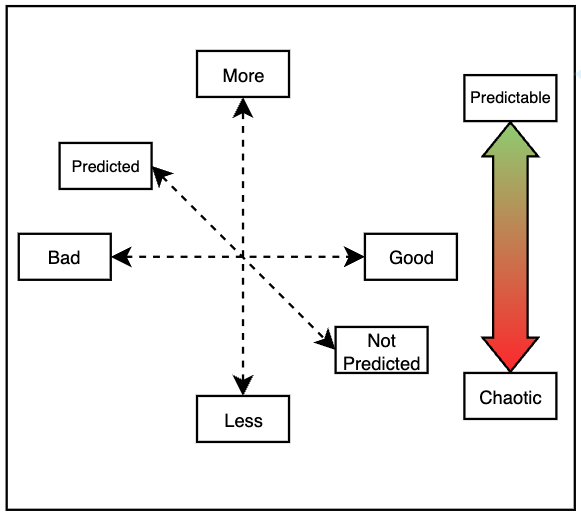
Y Axis : Directional Preference
This indicates whether we want our need value to go higher or lower. For example, if your hand is cold, you want its temperature to go up. However, if your hand is hot, you want its temperature to go down.
X Axis : Is My Preference Happening?
We experience joy when we are moving in our preferred direction and sadness when moving against it.
If I want my hand to cool down and it is cooling down then I feel good. If I want my hand to cool down and it is getting warmer, then I feel bad. Conversely, if my hand is cold and I want it to warm up, cooling it makes me feel bad while warming it feels good.
An interesting observation regarding the Joy-Sadness axis is that happiness is a change in state that aligns with a need. If your needs are all easily satisfied, you spend little time and little mental effort aligning with needs. Bye bye happiness.
Z Axis : Is This Predictive Success?
If we are in familiar territory we feel confident in our predictions and surprised when they fail. When we are in unfamiliar situations, those reverse and we are surprised at successes. We like surprises that reinforce joy and we dislike surprises that make us sad.
The Fourth Emotional Dimension : Predictable or Chaotic
Trust means predictability and predictability is what we internalize. If I can predict the nature of my religion or nation better than others then I internalize this idea that they are a part of me. My arm is very predictable to me and is internalized to the point that I know not to eat it when hungry. It does what I tell it to and when I make predictions about its behaviors I am always right.
The opposite of trust is disgust.
It is a horror movie trope that a hand takes control of itself and attacks its owner. The reason that is such an effective trope is because it signifies a trusted thing that was fully internalized suddenly transitioning into being other. Even worse, a hostile other.
When we feel like we are unable to make predictions about things or in other words, understand them, we are encountering chaos. Unlike the internalization of trust, with more chaos, we like to reject and externalize the untrustable.
Chaotic things are the sea, a dark forest at night, storms. Prior to modern medicine, disease seemed like a much more chaotic thing than today.
If I am playing a game and understanding the rules then I will like it and internalize myself as a player of that game. If I can not make sense of the rules, then I will reject the game and not want to play it any more because to me it is chaos.
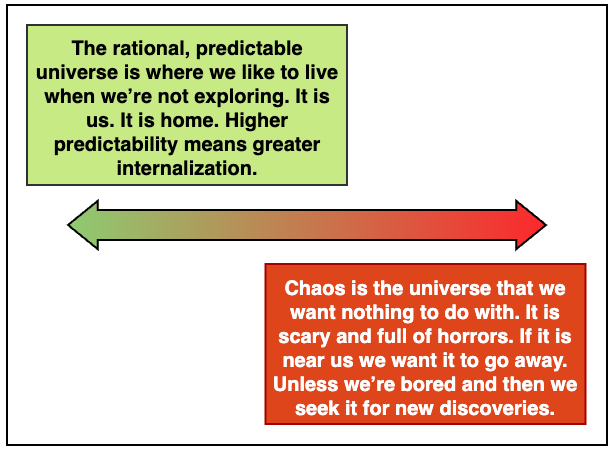
4 Dimensional Emotions
With this new compass I could see how it could explain a variety of known phenomena in pharmacology and psychology. Here are a couple of diagrams to show what I was attempting.
In the example in figure 5, I consider a memory about a running faucet when the temperature need of the hand wants to get cooler and remembers that cold water from a past faucet made that real.
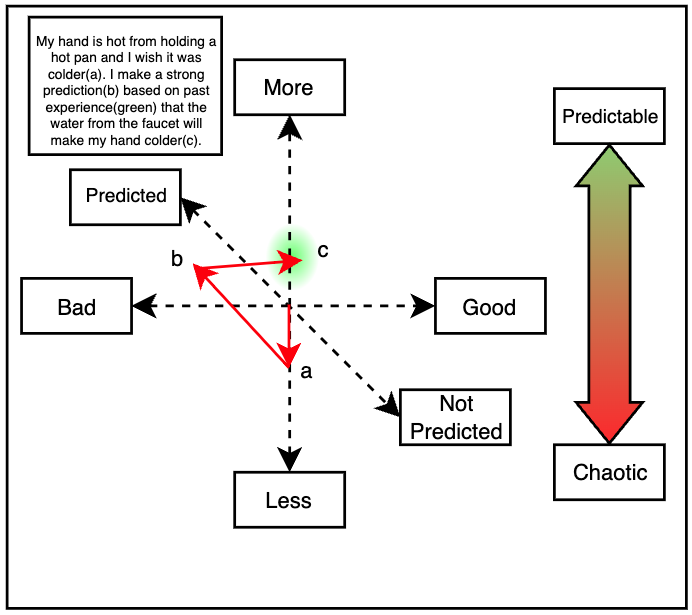
Note that we want temperature to be less than it is. The direction we predict water from the faucet will take us is good for that preference. We have strong confidence in the faucet that's running because that's what happened consistently in the past. Things are green because we are in a predictable world.
Unfortunately for us, the tap was set to hot instead of cold. If we look at figure 6, temperature went to more which is bad(c) for our preferred direction(a). We failed a prediction which means we are in surprise(b). Also, since this goes against a previous strong prediction, faucets have just become a lot more chaotic to me(red).
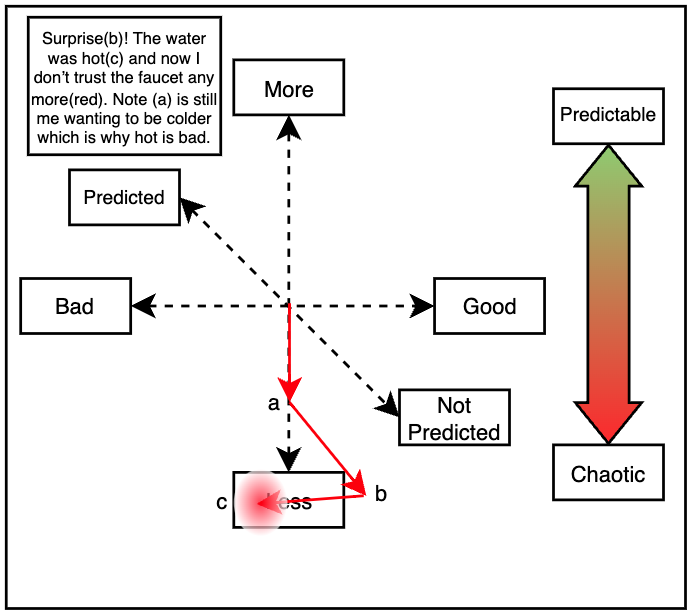
In the future I could choose to investigate faucets more to make some of that chaos go away or I could choose to reduce my exposure to them to reduce the chaos in my life. Depending on my environmental factors and temperament it would eventually be a combination of both.
Additional Examples
Figure 5 could just as easily be a desire to have less energy at the end of the day. I want to have less energy (a), I make a strong prediction that by going to work, I will burn off energy(b) and (c). If all goes well, my prediction works out and remains green.
When I am hungry, I may make a strong prediction(b) of eating a sandwich and reducing my hunger (a) + (c). In this case, figure 6 could be my reaction when discovering that my sandwich was expired or had been eaten.
I could sketch out concepts and seeing the function of each axis out front was very useful though getting multiple ideas on one map was challenging. Later in this paper I will describe what I think is a better visualization.
Functional Emotions
Animals are biological systems, and biological systems drive towards homeostasis as a function of survival. Neurological systems training to keep those animals alive would be driven to keep biological measures of various kinds within comfortable limits and outside of painful limits.

If we look at the example above (figure 7), I get uncomfortable when the temperature goes below 60 and am in pain below 35. In those cases, my preference would be for temperature to go up.
If the temperature is above 85, then I prefer for the temperature to go down.
Every biological need within a system has a comfortable zone that is surrounded by discomfort and then pain. The emotional mind trains its behaviors around ensuring its opportunities to bring its needs into the comfort zone.
The more-less axis is a scalar pointing us in the direction away from pain. Solving for different extremes of a condition can require completely different mindsets. Memes that drive the need in opposite directions occupy different emotional spaces.
The good-bad axis is a scalar indicating the relationship of this meme with values of the need involved. The same room temperature water means different things depending on whether you want to make something hot cool or make something cold warm.
The prediction-success axis is a scalar describing what would constitute surprise for this state of the observed rational universe.
The predictable-chaotic axis maps the relationship of our prediction successes with the behavior of the other 2 axes.
Together, these axes participate in a mechanism that trains neuron based memes to use information about the world that comes in as meaningless senses to make that world a predictable map for satisfying our desire to avoid discomfort and pain.
To accomplish this, a brain marks events that happen to it during awake periods which signal an emotional shift. [3] At night the mind reviews the emotionally significant parts of the day and attempts to summarize [4] them using abstractions that either already exist from past emotional dreams or are formed as guesses about relevant details for which there are no memes yet. The next morning, the mind wakes up with new ideas. [5](I will explore the mechanisms for this in my next paper on Artificial General Intelligence.)
Since every abstraction in the past is tied to some emotional vector, those emotional vectors get to weigh in on how we feel from moment to moment in regards to our needs, ourselves and our environments.
The Emotion Card
The interface to a tool is critical to the usefulness of that tool. I needed something easier to use and to conceptualize with than figures 3 - 6.
This emotion card (figure 8) has been working pretty well for me so far. Left to right is the distinction between self and the chaotic universe. Top is our expectations being met while bottom is prediction failures. Within each group we have the direction of change on the left and the preferred direction on the right.
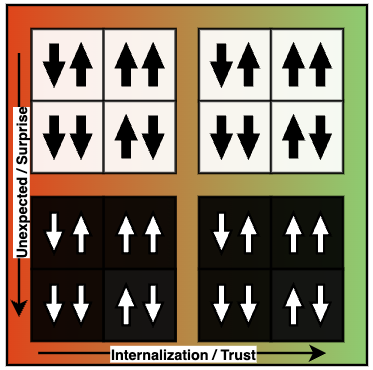
In figure 9 I am encouraged by a friend to try sushi for the first time. It is chaotic because it is something from the "away universe" (left of card). I would like things to taste good (right arrow) but my predicted expectation(top of card) is that it would taste bad (left arrow).
I try the sushi and to my surprise, this external thing defied my expectation. As a result, my updated map of the world will soon be one where sushi is expected to be good for wanting good flavored food, predictable and within my trusted space which will eventually become such a part of my definition of self that I will treat attacks on sushi as attacks on me.
Note how a positive surprise acts to change the emotional definition of the underlying meme.
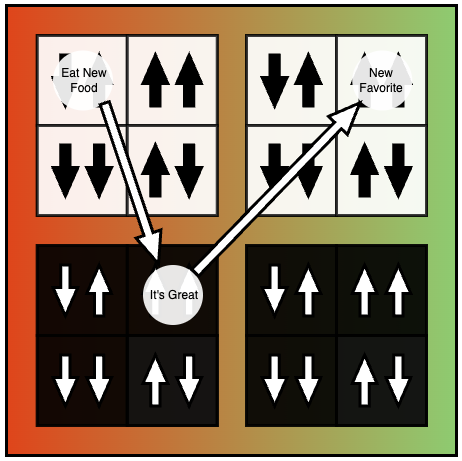
Some time later when I am integrating all this wonderful information, I will also interrogate my suspicion of trying new foods (developed from some distasteful vegetable in my early childhood) and try to extract a difference between the experiences. I might settle on the idea that recommendations from friends were the difference or I might decide that its only this specific friend and so on.
For another example going in the chaotic direction, lets visit Bob in figure 10. Bob was on a business trip but got the great news that they were done with the client early so he could get home on an earlier flight. Bob's emotional state relating to his partner is up(right arrow meaning that he's looking for more connection), good(left arrow indicating that seeing his partner would elevate that connection), everything is normal(top of card because we're making strong predictions) and completely internalized(right side of card because he trusts his partner).
Unfortunately for Bob, on arriving at home he discovered his partner has violated his informed consent by cheating on him.
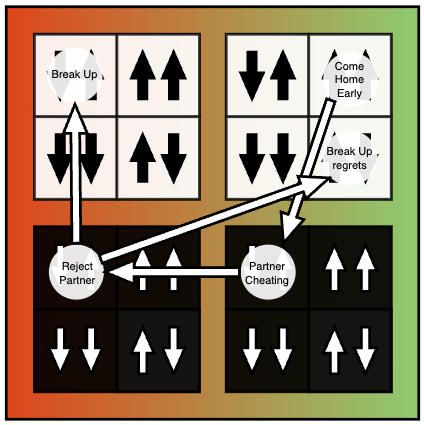
Instead of the expected result, Bob finds himself in up, bad, surprise and self which is an unacceptable state(bad surprise) so Bob's partner is de-internalized which is experienced as disgust. The de-internalization is a form of invalidation of earlier forms of trusted models. It means that any back to front scan of our emotional opinion of something will be short circuited when it arrives at this memory... if not to derail us, then to make us pay attention.
Now that Bob's partner has been made chaotic, Bob can reevaluate and initially form a chaotic externalization of their partner as being bad for wanting to feel connection and then eventually an internalized meme for memories that can consistently "help" bring him down.
Suppose Bob's subconscious sees all this and has all kinds of other considerations for why Bob should not want his partner out of his life... Figure 11 shows that Bob has options that keep their partner on this side of predictability.
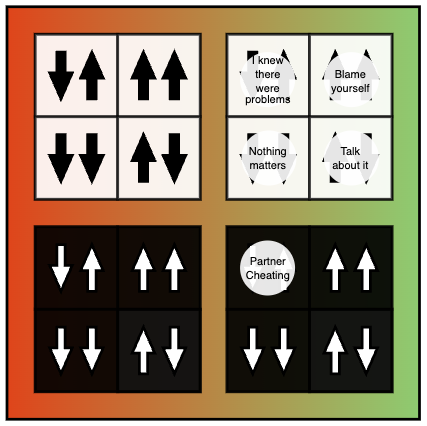
The goal of the system is to produce hierarchical concepts that allow it to make useful predictions about its environment for meeting the needs that drive its pain and discomfort. Some of those hierarchical concepts are sequential scripts. Some are self perpetuating near time expectations.
Every waking period we accumulate memories of what was happening to us when an existing card was either strongly validated or surprised. Those signals are what drives feature extraction from our memory surrounding the situation.
Why is this important?
Psychology of Self
Once you understand the component drivers of an emotion, it is much easier to interrogate your situation to try to understand why you are feeling the way that you are and what your emotion is trying to tell you. Maybe you need to learn more about the subject of interest in order to make it less chaotic? On the other hand, maybe you have a need who's comfort zone you would like to work on. If you know what portions of a problem you should look at, it becomes much easier to lead an emotionally aligned life.
I have begun to map various psychological phenomena using these mechanisms and I am sure I will end up writing about some of them in the future if someone else doesn't beat me to them.
Cognition
Once one has a good working model for what the emotions are doing in relation to neurological behavior and training, it becomes easier to model (albeit in the abstract) functional expectation in the human brain.
Here is one such expectation: https://twitter.com/WickedViper23/status/1568341160736743427?s=20&t=aPG4OMH2C1ID3P2m6GYhrQ
And another:
https://twitter.com/WickedViper23/status/1569344957252771844?s=20&t=aPG4OMH2C1ID3P2m6GYhrQ
As I continue looking I expect to find many more.
Artificial General Intelligence
Understanding the mechanisms underlying human cognition and learning is a core competency that we need to get our minds around if we are to replicate such functionality in a machine intelligence.
I expect that we will find that the above emotional system is heavily involved in perception, feature extraction and decision making... basically, I expect it to be the foundation of how humans do intelligent things.
- ^
Hume, David (2003). A treatise of human nature. Courier Corporation.
- ^
https://en.wikipedia.org/wiki/Emotional_intelligence#/media/File:Plutchik_Dyads.svg
- ^
Grella, S.L., Fortin, A.H., Ruesch, E. et al. Reactivating hippocampal-mediated memories during reconsolidation to disrupt fear. Nat Commun 13, 4733 (2022) discuss intermingling emotional states associated with 2 different ideas to impact the emotional content of the feared idea.
- ^
E. E. Davis & K. L. Campbell (2022) Event boundaries structure the contents of long-term memory in younger and older adults, Memory, DOI: 10.1080/09658211.2022.2122998
- ^
Evolution of predictive memory in the hippocampus
Adam M. P. Miller, Alex D. Jacob, Adam I. Ramsaran, Mitchell L. De Snoo, Sheena A.Josselyn, Paul W. Frankland
bioRxiv 2022.09.08.507204; doi: https://doi.org/10.1101/2022.09.08.507204
0 comments
Comments sorted by top scores.